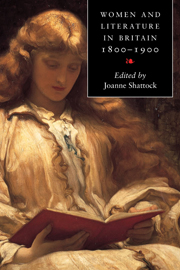Book contents
- Frontmatter
- Contents
- List of contributors
- Acknowledgments
- Chronology
- Introduction
- 1 The construction of the woman writer
- 2 Remaking the canon
- 3 Women and the consumption of print
- 4 Women writing woman: nineteenth-century representations of gender and sexuality
- 5 Feminism, journalism and public debate
- 6 Women's writing and the domestic sphere
- 7 Women, fiction and the marketplace
- 8 Women poets and the challenge of genre
- 9 Women and the theatre
- 10 Women writers and self-writing
- 11 The professionalization of women's writing: extending the canon
- 12 Women writers and religion
- 13 Women writing for children
- Guide to further reading
- Index
9 - Women and the theatre
Published online by Cambridge University Press: 03 October 2009
- Frontmatter
- Contents
- List of contributors
- Acknowledgments
- Chronology
- Introduction
- 1 The construction of the woman writer
- 2 Remaking the canon
- 3 Women and the consumption of print
- 4 Women writing woman: nineteenth-century representations of gender and sexuality
- 5 Feminism, journalism and public debate
- 6 Women's writing and the domestic sphere
- 7 Women, fiction and the marketplace
- 8 Women poets and the challenge of genre
- 9 Women and the theatre
- 10 Women writers and self-writing
- 11 The professionalization of women's writing: extending the canon
- 12 Women writers and religion
- 13 Women writing for children
- Guide to further reading
- Index
Summary
The theatre of the nineteenth century offered women irresistible opportunities for independence, action, agency, fame and money. Yet participation in the theatre also threatened loss of position and reputation, exhaustion, frustration, exploitation and poverty. The theatre as a profession (for middle-class women particularly) challenged the ideals of self-effacement and control of women's ‘natural’ voracious desires which Mary Poovey argues are at the heart of the idea of the ‘proper lady’. However, as Kerry Powell argues in the case of actresses, the theatre also offered women the opportunity to ‘speak compellingly’. In spite of the difficulties of negotiating this tricky territory, women moved into the theatre in large numbers throughout the nineteenth century, and their participation in the theatre industry constitutes one of the more visible instances of women's increasing autonomy and self-definition through work in the period. Women's participation in the theatre was all the more important as the theatre was, in effect, a mass medium of the nineteenth century. But the theatre in the nineteenth century was not simply an entertainment industry: it was an important part of the discursive construction of English (and I use this term deliberately) national culture. If we adopt Benedict Anderson's concept of the nation as an ‘imagined community’, then the theatre was a vital part of that imagining, and women in the theatre were defining and participating in one of the more significant constructions of ‘cultural nationhood’ in the period.
- Type
- Chapter
- Information
- Women and Literature in Britain 1800–1900 , pp. 189 - 208Publisher: Cambridge University PressPrint publication year: 2001
- 1
- Cited by



